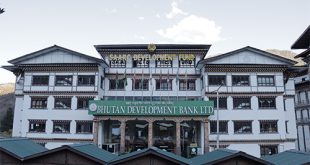One normally associates land pooling and Local Area Plans (LAPs) with urban places, like Thimphu and Phuentsholing, but for the first time, in a major exercise, the entire Paro valley area from Shabha Gewog in the south to Zhiwaling in Tsento Gewog in the North will come under 36 LAPs that will cover 36 sq km within the 13th Five-Year Plan (FYP). For comparison, the current Thimphu Thromde boundary covers 26 sq km or Samdrupjongkhar LAP covers 4 sq km.
The LAPs are 36 in number, but there are efforts going on to combine them into 15 LAPs for convenience.
A Ministry of Infrastructure and Transport (MoIT) official said the main source document is the Comprehensive National Development Plan from which the Paro and Thimphu Regional Strategy is drawn, and there is then the Paro Valley Development Plan.
The 36 or so LAPs in Paro are a combination of all of the above.
The LAPs are based on NSB population projections till 2047 which says the existing population of Paro, will grow from in 46,316 in 2017 to 74,067 in 2047.

LAPs and its value
The aim is that once it is fully implemented, the LAPs will change the very face of Paro with a Taba LAP level of planning even in Paro’s villages with right of way, broad streets, storm water drainage, sewage, street lights and neatly arranged plots.
The Chuzing or the wetland areas will remain untouched, and mainly be kept as it is in the interest of national food security.
The first four LAPs that started around four months ago and are in the process of planning are Paro Tshongdue, Bondey, Lamgong Gewog and Shabha Gewog.
The land pooling percentage is around 25% of the land for the town and rural areas alike in these 4 LAPs. The pooling is from 12% to 30% depending on one’s location or state land availability, but most come under the 25% pooling.
There was a misperception and even panic among rural residents that gewogs like Shabha and Lamgong were being turned into towns, but authorities assure that their rural nature and characteristics will remain.
The official said that people assume LAPs are only done in places like Thimphu, but he said the ministry and local governments have done 128 LAPs all over Bhutan like Khaling LAP, Narphung LAP, Taktse LAP, Dagapela LAP, Lhamodzingkha LAP, etc.
That said, the above LAPs were mainly small settlement sized for growth areas, but what is being done in Paro is the largest ever LAP development in Bhutan after Thimphu.
The MoIT official said that the LAP is like a value creation for Paro, and the LAP will become the basis for government investment into infrastructure in Paro.
He said the cost benefit may not be seen in the short term, but there is a long term cost benefit.
The MoIT official said that land pooling is a must, as this is the only way that land can be freed up for public infrastructure and utilities. He said the public perception is that ‘the government is taking away land’ but he said the land will go nowhere and be there to benefit all.
The official said if Paro is allowed to grow like this without LAPs then there will be complete chaos in the future.
Zones and Precincts
Under the plan, Paro will have the Cultural Landscape Zone and the Built Environment Zone.
The Cultural Landscape Zone includes areas such as agricultural precincts (Chuzhing), which will be protected; religious precincts like Lhakhangs; the Paro Dzong precinct; open-space precincts such as playgrounds, parks, and recreational areas; waterfront precincts with a buffer zone of 30 metres for the Pachu and Dochu rivers and 15 metres for major streams; environmentally sensitive precincts with steep slopes and high-hazard areas; and forest precincts.
In the Built Environment Zone there will be a high density commercial town center precinct which is Paro Tshongdue. Here, the minimum plot size is 5.5 decimals and the building height is 5 floors with 60% coverage allowed.
Another is Neighborhood node which will be medium density with mixed use and commercial development like small towns in Bondey, Shabha, Lamgong and Luchi. Here 4 floors are allowed with 40% coverage.
There is then Rural Residential for medium density residential and mixed use area with 3 floors and 40% coverage. Institutional use can happen provided the land is 24.7 decimals and hotels or resorts can happen on a minimum plot size of 61.7 decimals.
There is a low density rural residential precinct with steeper slope with 3 floors and 30% coverage. Hotels or resorts can happen on a minimum plot size of 61.7 decimals.
There is a traditional village precinct which will preserve and promote existing settlement clusters with rich traditional architectural features. The coverage is 40% and three floors are allowed. Activities like local handicraft and homestay may be permitted.
The Heritage Village precinct is for historical or traditional settlements. This allows 50% coverage and 3 floors.
The Institutional precinct is land earmarked for schools, offices and other institutions. Here, the minimum plot size is 25 decimals and coverage is 30%.
Paro will have an Industrial precinct which is for industrial and manufacturing units. Here, the minimum plot size is 25 decimals and coverage is 30% with three floors.
There will then be a service precinct for services but not limited to bus terminal, taxi stand, truck parking, workshops, sewage treatment plants, etc. The minimum plot size is 13 decimals and coverage is 50% with three floors.
There is then the airport and military precincts covering the respective areas.
The minimum plot size for neighbourhood node, rural residential, low density rural residential, traditional village and heritage village is 13 decimals.
In some cases, some Chuzing areas which are trapped in between settlement could be converted and in certain cases if important infrastructure is to be built then it can also be built through Chuzing areas.
In water stressed Shabha, a common issue raised is that some land, particularly above the highway, are Chuzing in name but have no water, and so there is a request to allow them to be converted into Kamzhing.
Here, the Ministry of Agriculture and Livestock and the National Land Commission are doing a Chuzing assessment in Paro and in these LAP areas.
The four LAPs under development will take up to a year with the process starting around 4 months ago.
After the LAP is ready then the next stage is looking at actual infrastructure that can be put on the ground.
The first priority will have to be blacktopped roads and storm water drainage followed by other amenities. The roads are being made wide so that there can be footpaths and electric lines can go underground. In the longer run things, like sewage lines, etc., need to be put in.
Economic focus
The LAPs are not just a planning exercise but also an economic one. It identifies key existing and emerging employment sectors and their location. In Paro, these include the agro-tourism and homestays sector in Upper Paro Valley and Dopshari Valley, commercial area in Paro Town, agri-business and manufacturing in Bondey and Shaba, as well as higher educational institutions in the south of Paro Valley. The key sectors of employment also consider new tourism strategies, such as third sector tourism.
Upper Paro Valley will have protections, with focus on rural livelihoods. Dopshari Valley will also have protections, with focus on rural livelihoods
Paro Town will have mixed use western extension. Bondey will be a model new settlement, with balanced employment focus, south of airport
Shaba will be reserved for future potential
An official said that a place like Paro plays an important role in the overall landscape of the country, and so they don’t want a situation where Paro, like Thimphu, is converted into a concrete jungle.
For housing, the focus is affordable housing for all and quality of life. For population, the plan is for balanced distribution and equal opportunities.
Concerns and solutions
In a dzongkhag with a primarily rural nature, where people are closely tied to the land and know its rising value, the sudden incoming of LAPs, especially in the rural settings, is coming with its fair share of hope, fears, doubts and challenges.
The Lamgong Gup, Gem Tshering, said that public consultation has happened three times attended by the Dzongda and the MoIT officials.
He said people are willing to do land pooling for the LAPs, but they are also concerned about it being 25% and recommend making it lesser or using more government land instead of leaving them untouched. He said people are also asking if they can be given satshab or land replacement where possible.
The Lamgong Gup said there is also concern on only three floors being allowed. The Gup said there is also worry about the buffer zone being kept for smaller streams. The Gup said a major worry is that the planning should move to schedule and be completed after a definite date after which, there should be developmental activities happening and being allowed. He also said a new government should not come and change the plans again like it happened in the past.
The Gup said he is also worried about very poor residents in the LAP, some of whom have never been to Thimphu and for whom he had to collect the Lagthram from Thimphu. He wonders if they even know what is going on.
The Lamgong Mangmi, Sangay Khandu, said people are also worried that the LAP process takes forever like Kabesa in Thimphu and Dekiling in Bumthang with no developmental activities allowed. He said there is also worry on if the government has the budget to carry out developmental works after the LAP is done.
The Shabha Gup, Sangay Lhamo, said that when she came in, one issue in Shabha was the lack of proper roads and parking, especially the road to Shabha Primary school. She said she got the plans and budget to make a wider road and put drainage and lights, but the LAP came up and so it had to be put on hold.
The Gup, Sangay Lhamo, said that planning is needed in Shabha because the ordinary mindset is to want water, power, road and other facilities, but not on one’s land and so land pooling takes care of that.
The Gup said that concern in Shabha is that there are certain areas registered as Chuzing, but there is no water to cultivate them and so if they can be converted to Kamzhing for development. She said another challenge is for people with very small landholdings.
One more concern is on if so many looping roads from the front and back are required, which is taking up more land.
She pointed out that one worry is that currently a lot of developmental activities and construction is held up in Shabha pending the LAP, and so the hope is that they can happen once the LAP is done.
The Shabha Mangmi said another worry is that if Shabha will truly have the growth and activities that can justify the LAP that comes up and the land pooling done.
The Paro Dzongda, Norbu Wangchuk, said that when it comes to budget for developmental works post the LAPs, he said all they get us the annual grants which is spent for plan activities.
The Dzongda said that in the public consultations one key concern was that the LAPs should not result in Kabesa, Thimphu or Dekiling town, Bumthang like situations where the process takes too long and so no development happens where the public are unable to construct which harms the public and the nation.
He said the other concern was on if resources are there for constructions works post the LAP and here, he said recently some MoIT officials indicated there is some budget for some service roads.
The Dzongda said that by and large the people seem to be okay with the LAPs.
On the prospects for Paro after the LAPs, the Dzongda said there is a real growth prospect in Paro as it is one of the most beautiful valleys with plane land and the international airport which is being expanded. He said once the Gelephu Mindfulness City (GMC) comes up in a few years then traffic to Paro will increase and the rich investors in GMC may want summer homes or offices in Paro. He said the local economy will improve. The Dzongda also said that over time, more people will settle in Paro.
Water is a major issue in Paro, and here, the Dzongda said that Paro has around Nu 300 million worth of three water flagship programs. The Dragey Pangtsho scheme from Dotey will benefit Shabha, Wangcha, Dotey, Hungrel and Dopshari. The Balakha project in Tsento will benefit Tsento, Lamgong, Lungnyi gewog, Wangchang. The Choki Dentsha project will benefit Dopshari, Dotey, Hungrel and Wangchang.
 The Bhutanese Leading the way.
The Bhutanese Leading the way.




